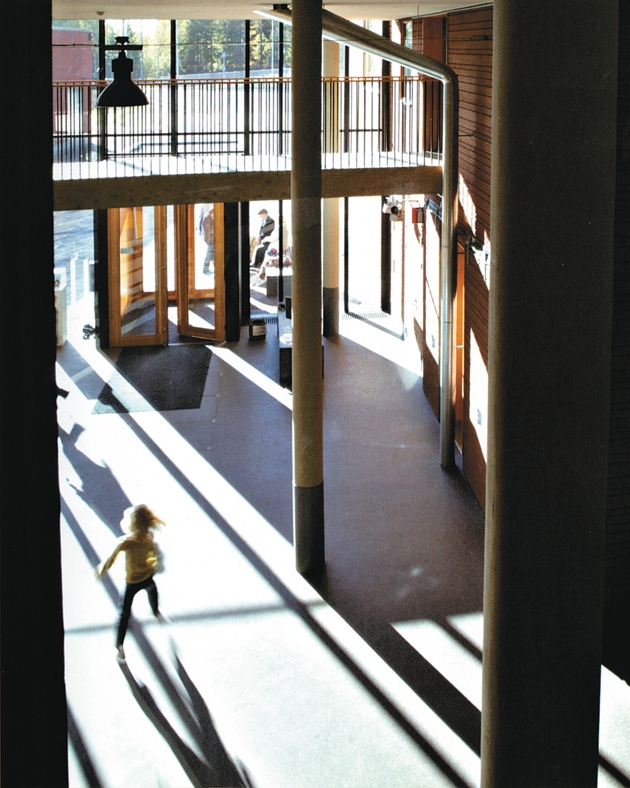
Tuomas Uusheimo
The Kirkkojärvi School in Espoo, Finland, which accommodates about 770 students aged seven to sixteen and also includes a preschool for six-year-olds; from the Museum of Finnish Architecture’s exhibition ‘The Best School in the World: Seven Finnish Examples from the 21st Century,’ which will be on view at the American Institute of Architects’ Center for Architecture in New York City this fall
In recent years, elected officials and policymakers such as former president George W. Bush, former schools chancellor Joel Klein in New York City, former schools chancellor Michelle Rhee in Washington, D.C., and Secretary of Education Arne Duncan have agreed that there should be “no excuses” for schools with low test scores. The “no excuses” reformers maintain that all children can attain academic proficiency without regard to poverty, disability, or other conditions, and that someone must be held accountable if they do not. That someone is invariably their teachers.
Nothing is said about holding accountable the district leadership or the elected officials who determine such crucial issues as funding, class size, and resource allocation. The reformers say that our economy is in jeopardy, not because of growing poverty or income inequality or the outsourcing of manufacturing jobs, but because of bad teachers. These bad teachers must be found out and thrown out. Any laws, regulations, or contracts that protect these pedagogical malefactors must be eliminated so that they can be quickly removed without regard to experience, seniority, or due process.
The belief that schools alone can overcome the effects of poverty may be traced back many decades but its most recent manifestation was a short book published in 2000 by the conservative Heritage Foundation in Washington, D.C., titled No Excuses. In this book, Samuel Casey Carter identified twenty-one high-poverty schools with high test scores. Over the past decade, influential figures in public life have decreed that school reform is the key to fixing poverty. Bill Gates told the National Urban League, “Let’s end the myth that we have to solve poverty before we improve education. I say it’s more the other way around: improving education is the best way to solve poverty.” Gates never explains why a rich and powerful society like our own cannot address both poverty and school improvement at the same time.
For a while, the Gates Foundation thought that small high schools were the answer, but Gates now believes that teacher evaluation is the primary ingredient of school reform. The Gates Foundation has awarded hundreds of millions of dollars to school districts to develop new teacher evaluation systems. In 2009, the nation’s chief reformer, Secretary of Education Arne Duncan, launched a $4.35 billion competitive program called Race to the Top, which required states to evaluate teachers by student test scores and to remove the limits on privately managed charter schools.
The main mechanism of school reform today is to identify teachers who can raise their students’ test scores every year. If the scores go up, reformers assume, then the students will enroll in college and poverty will eventually disappear. This will happen, the reformers believe, if there is a “great teacher” in every classroom and if more schools are handed over to private managers, even for-profit corporations.
The reformers don’t care that standardized tests are prone to measurement error, sampling error, and other statistical errors.1 They don’t seem to care that experts like Robert L. Linn at the University of Colorado, Linda Darling-Hammond at Stanford, and Helen F. Ladd at Duke, as well as a commission of the National Research Council, have warned about misuse of standardized tests to hold individual teachers accountable with rewards or sanctions. Nor do they see the absurdity of gauging the quality of a teacher by the results of a multiple-choice test given to students on one day of the year.
Testing can provide useful information, showing students and teachers what is and is not being learned, and scores can be used to diagnose learning problems. But bad things happen when tests become too consequential for students, teachers, and schools, such as narrowing the curriculum only to what is tested or cheating or lowering standards to inflate scores. In response to the federal and state pressure to raise test scores, school districts across the nation have been reducing the time available for the arts, physical education, history, civics, and other nontested subjects. This will not improve education and is certain to damage its quality.
No nation in the world has eliminated poverty by firing teachers or by handing its public schools over to private managers; nor does research support either strategy.2 But these inconvenient facts do not reduce the reformers’ zeal. The new breed of school reformers consists mainly of Wall Street hedge fund managers, foundation officials, corporate executives, entrepreneurs, and policymakers, but few experienced educators. The reformers’ detachment from the realities of schooling and their indifference to research allow them to ignore the important influence of families and poverty. The schools can achieve miracles, the reformers assert, by relying on competition, deregulation, and management by data—strategies similar to the ones that helped produce the economic crash of 2008. In view of the reformers’ penchant for these strategies, educators tend to call them “corporate reformers,” to distinguish them from those who understand the complexities of school improvement.
Advertisement
The corporate reformers’ well-funded public relations campaign has succeeded in persuading elected officials that American public education needs shock therapy. One is tempted to forget that the United States is the largest and one of the most successful economies in the world, and that some part of this success must be attributed to the institutions that educated 90 percent of the people in this nation.
Faced with the relentless campaign against teachers and public education, educators have sought a different narrative, one free of the stigmatization by test scores and punishment favored by the corporate reformers. They have found it in Finland. Even the corporate reformers admire Finland, apparently not recognizing that Finland disproves every part of their agenda.
It is not unusual for Americans to hold up another nation as a model for school reform. In the mid-nineteenth century, American education leaders hailed the Prussian system for its professionalism and structure. In the 1960s, Americans flocked to England to marvel at its progressive schools. In the 1980s, envious Americans attributed the Japanese economic success to its school system. Now the most favored nation is Finland, and for four good reasons.
First, Finland has one of the highest-performing school systems in the world, as measured by the Programme for International Student Assessment (PISA), which assesses reading, mathematical literacy, and scientific literacy of fifteen-year-old students in all thirty-four nations of the Organisation for Economic Co-operation and Development (OECD), including the United States. Unlike our domestic tests, there are no consequences attached to the tests administered by the PISA. No individual or school learns its score. No one is rewarded or punished because of these tests. No one can prepare for them, nor is there any incentive to cheat.
Second, from an American perspective, Finland is an alternative universe. It rejects all of the “reforms” currently popular in the United States, such as testing, charter schools, vouchers, merit pay, competition, and evaluating teachers in relation to the test scores of their students.
Third, among the OECD nations, Finnish schools have the least variation in quality, meaning that they come closest to achieving equality of educational opportunity—an American ideal.
Fourth, Finland borrowed many of its most valued ideas from the United States, such as equality of educational opportunity, individualized instruction, portfolio assessment, and cooperative learning. Most of its borrowing derives from the work of the philosopher John Dewey.
In Finnish Lessons: What Can the World Learn from Educational Change in Finland?, Pasi Sahlberg explains how his nation’s schools became successful. A government official, researcher, and former mathematics and science teacher, Sahlberg attributes the improvement of Finnish schools to bold decisions made in the 1960s and 1970s. Finland’s story is important, he writes, because “it gives hope to those who are losing their faith in public education.”
Detractors say that Finland performs well academically because it is ethnically homogeneous, but Sahlberg responds that “the same holds true for Japan, Shanghai or Korea,” which are admired by corporate reformers for their emphasis on testing. To detractors who say that Finland, with its population of 5.5 million people, is too small to serve as a model, Sahlberg responds that “about 30 states of the United States have a population close to or less than Finland.”
Sahlberg speaks directly to the sense of crisis about educational achievement in the United States and many other nations. US policymakers have turned to market-based solutions such as “tougher competition, more data, abolishing teacher unions, opening more charter schools, or employing corporate-world management models.” By contrast, Finland has spent the past forty years developing a different education system, one that is focused on
improving the teaching force, limiting student testing to a necessary minimum, placing responsibility and trust before accountability, and handing over school- and district-level leadership to education professionals.
To an American observer, the most remarkable fact about Finnish education is that students do not take any standardized tests until the end of high school. They do take tests, but the tests are drawn up by their own teachers, not by a multinational testing corporation. The Finnish nine-year comprehensive school is a “standardized testing-free zone,” where children are encouraged “to know, to create, and to sustain natural curiosity.”
I met Pasi Sahlberg in December 2010. I was one of a dozen educators invited to the home of the Finnish consul in New York City to learn about the Finnish education system on the day after the release of the latest international test results. Once again, Finland was in the top tier of nations, as it has been for the past decade. Sahlberg assured the guests that Finnish educators don’t care about standardized test scores and welcomed the international results only because they protected the schools against conservative demands for testing and accountability.
Advertisement
Finnish teachers, Sahlberg said, are well educated, well prepared, and highly respected. They are paid about the same as teachers in the United States in comparison to other college graduates, but Finnish teachers with fifteen years’ experience in the classroom are paid more than their American counterparts. I asked Sahlberg how it was possible to hold teachers or schools accountable when there were no standardized tests. He replied that Finnish educators speak not of accountability, but of responsibility. He said, “Our teachers are very responsible; they are professionals.” When asked what happens to incompetent teachers, Sahlberg insisted that they would never be appointed; once qualified teachers are appointed, it is very difficult to remove them. When asked how Finnish teachers would react if they were told they would be judged by their students’ test scores, he replied, “They would walk out and they wouldn’t return until the authorities stopped this crazy idea.”
Sahlberg invited me to Finland to tour several schools, which I eventually did in September 2011. With Sahlberg as my guide, I visited bright, cheerful schools where students engaged in music, dramatics, play, and academic studies, with fifteen-minute recesses between classes. I spoke at length with teachers and principals in spacious, comfortable lounges. Free from the testing obsession that now consumes so much of the day in American schools, the staff has time to plan and discuss the students and the program.
Before I left Finland, Sahlberg gave me a book called The Best School in the World: Seven Finnish Examples from the 21st Century,3 about the architecture of Finnish schools. The book is based on an exhibition presented at the Venice Biennale of Architecture in 2010. When we visited one of the featured schools, I thought, how delightful to discover a nation that cares passionately about the physical environment in which children learn and adults work.
To be sure, Finland is an unusual nation. Its schools are carefully designed to address the academic, social, emotional, and physical needs of children, beginning at an early age. Free preschool programs are not compulsory, but they enroll 98 percent of children. Compulsory education begins at the age of seven. Finnish educators take care not to hold students back or label them as “failing,” since such actions would cause student failure, lessen student motivation, and increase social inequality. After nine years of comprehensive schooling, during which there is no tracking by ability, Finnish students choose whether to enroll in an academic or a vocational high school. About 42 percent choose the latter. The graduation rate is 93 percent, compared to about 80 percent in the US.
Finland’s highly developed teacher preparation program is the centerpiece of its school reform strategy. Only eight universities are permitted to prepare teachers, and admission to these elite teacher education programs is highly competitive: only one of every ten applicants is accepted. There are no alternative ways to earn a teaching license. Those who are accepted have already taken required high school courses in physics, chemistry, philosophy, music, and at least two foreign languages. Future teachers have a strong academic education for three years, then enter a two-year master’s degree program. Subject-matter teachers earn their master’s degree from the university’s academic departments, not—in contrast to the US—the department of teacher education, or in special schools for teacher education. Every candidate prepares to teach all kinds of students, including students with disabilities and other special needs. Every teacher must complete an undergraduate degree and a master’s degree in education.
Because entry into teaching is difficult and the training is rigorous, teaching is a respected and prestigious profession in Finland. So selective and demanding is the process that virtually every teacher is well prepared. Sahlberg writes that teachers enter the profession with a sense of moral mission and the only reasons they might leave would be “if they were to lose their professional autonomy” or if “a merit-based compensation policy [tied to test scores] were imposed.” Meanwhile, the United States is now doing to its teachers what Finnish teachers would find professionally reprehensible: judging their worth by the test scores of their students.
Finland’s national curriculum in the arts and sciences describes what is to be learned but is not prescriptive about the details of what to teach or how to teach it. The national curriculum requires the teaching of a mother tongue (Finnish or Swedish), mathematics, foreign languages, history, biology, environmental science, religion, ethics, geography, chemistry, physics, music, visual arts, crafts, physical education, health, and other studies.
Teachers have wide latitude at each school in deciding what to teach, how to teach, and how to gauge their pupils’ progress. Finnish educators agree that “every child has the right to get personalized support provided early on by trained professionals as part of normal schooling.” Sahlberg estimates that some 50 percent of students receive attention from specialists in the early years of schooling. Teachers and principals frequently collaborate to discuss the needs of the students and the school. As a result of these policies, Sahlberg writes,
Most visitors to Finland discover elegant school buildings filled with calm children and highly educated teachers. They also recognize the large amount of autonomy that schools enjoy: little interference by the central education administration in schools’ everyday lives, systematic methods for addressing problems in the lives of students, and targeted professional help for those in need.
The children of Finland enjoy certain important advantages over our own children. The nation has a strong social welfare safety net, for which it pays with high taxes. More than 20 percent of our children live in poverty, while fewer than 4 percent of Finnish children do. Many children in the United States do not have access to regular medical care, but all Finnish children receive comprehensive health services and a free lunch every day. Higher education is tuition-free.
Sahlberg recognizes that Finland stands outside what he refers to as the “Global Education Reform Movement,” to which he appends the apt acronym “GERM.” GERM, he notes, is a virus that has infected not only the United States, but the United Kingdom, Australia, and many other nations. President George W. Bush’s No Child Left Behind law and President Barack Obama’s Race to the Top program are examples of the global education reform movement. Both promote standardized testing as the most reliable measure of success for students, teachers, and schools; privatization in the form of schools being transferred to private management; standardization of curriculum; and test-based accountability such as merit pay for high scores, closing schools with low scores, and firing educators for low scores.
In contrast, the central aim of Finnish education is the development of each child as a thinking, active, creative person, not the attainment of higher test scores, and the primary strategy of Finnish education is cooperation, not competition. I will consider the Teach for America organization—the subject of Wendy Kopp’s A Chance to Make History—in comparison to the Finnish model in a second article.
—This is the first of two articles.
This Issue
March 8, 2012
Work, Not Sex, At Last
Why Not Frack?
-
1
The best explanation of standardized testing is Daniel Koretz’s Measuring Up: What Educational Testing Really Tells Us (Harvard University Press, 2008). ↩
-
2
See Incentives and Test-Based Accountability in Education, edited by Michael Hout and Stuart W. Elliott (National Academies Press, 2011); Economic Policy Institute, “Problems with the Use of Test Scores to Evaluate Teachers,” August 29, 2010; and Center for Research on Education Outcomes, “Multiple Choice: Charter School Performance in 16 States,” Stanford University, June 2009. ↩
-
3
With essays by Pasi Sahlberg and others (Helsinki: Art-Print Oy, 2011), published in conjunction with the exhibition “The Best School in the World,” hosted by the Museum of Finnish Architecture in Helsinki, June 8–September 25, 2011. The exhibition will open in October 2012 at the American Institute of Architects’ Center for Architecture in New York City. ↩




